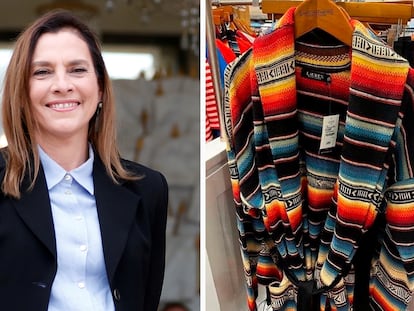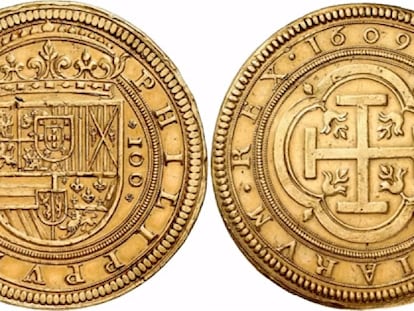Only a miracle (or an investor) can save the last tin workshop in Spain
Estaños de Pedraza has been working with this material for 55 years, but there is no one left to keep the craft alive
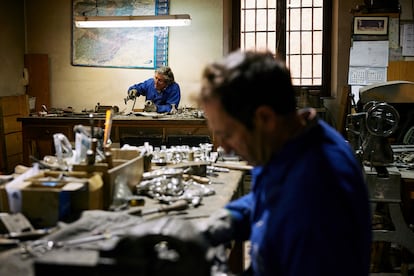
The last ingot that Estaños de Pedraza will ever melt sits on a rickety Darro chair. This small workshop in the town of Pedraza, in Spain’s Segovia province, has been working with tin for 55 years. At one point, 14 artisans were casting the valuable pieces, but now only three remain; these days, they work as a cooperative. This year, two of them will retire, and the remaining artisan will be forced to close the workshop. There are no apprentices or investors. This craft is one of the many that are being lost in Spain amid a strange paradox: appreciation for handcrafted work has increased, but artisans cannot find anyone to continue the tradition.
Estaños de Pedraza was founded by Paco Muñoz, who went on to gain international renown as an interior decorator and designer and as the founder of the furniture company Casa & Jardín [Home and Garden]. His daughter, Mafalda Muñoz – also an interior designer and co-founder of the Machado-Muñoz contemporary design gallery – recalls that her “father arrived in Pedraza on his Vespa scooter in the 1950s and fell in love with the town. He bought some dilapidated houses and got involved in the town’s conservation and rehabilitation.” The following decade, at the mayor’s request, Muñoz participated in a difficult task that continues to this day: attempting to prevent young people from leaving Pedraza because of a lack of opportunities. At the time, there was hardly any tourism, and the town only had a single asador, a restaurant specializing in grilled meat (today there are 15, and Pedraza has become a popular destination for its roast lamb). Muñoz had the felicitous idea of taking a couple of apprentices to Portugal to learn the tin craft; he then set up a workshop that ended up distributing more than 400 original pieces of his own design, which are still being made today: candlesticks, underplates, jugs, vases, ashtrays, soup bowls and the iconic hexagonal table lamps that are still seen in many inns (Muñoz was one of their main suppliers).
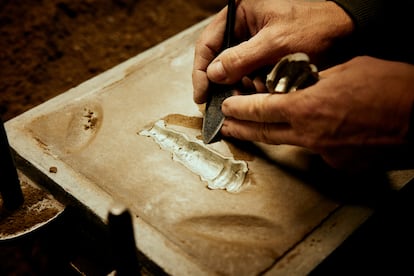
Some of Paco Muñoz’s friends helped him gain fame worldwide. Queen Fabiola of Belgium exchanged all her household goods for Pedraza tinworks. Nelson A. Rockefeller, one of the American tycoon’s heirs, visited the local store when he went to Spain to attend Francisco Franco’s funeral and bought everything in sight.
Although it is not a precious metal (some consider it the poor man’s silver), tin is not cheap. In fact, the fluctuation in price is one of the problems the business faces. The last ingot that will be melted down in the workshop weighs approximately 30 kilos (about 66 pounds). Just before the pandemic, a kilo (2.2 pounds) of tin cost about €28 (about $30); the last time artisan Gorete Pascual checked the price, it was about €50 (about $53). “Sometimes you don’t make [any profit]; it all goes toward the materials,” he says before putting tin in a 600-degree furnace. Gorete is one of three members of the dying cooperative. He is 61 years old and has practiced his craft at this workshop since he was 16. José Luis Hernán and Andrés Díaz also started working here at a young age. They have been at Estaños de Pedraza for almost five decades and will retire this year. Together, they will close the workshop down.
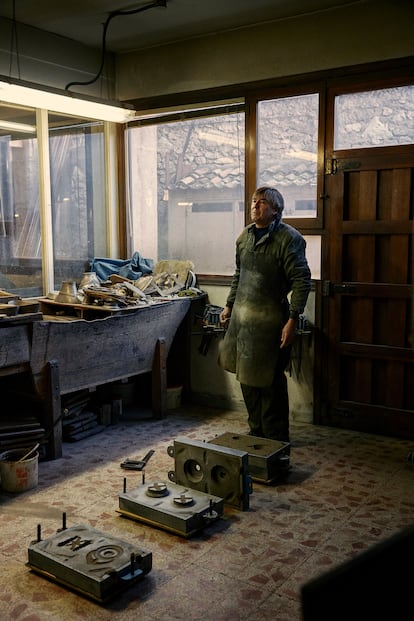
With their own hands, they have melted, reworked, soldered, welded, lathed, filed, polished and patinated between 1,100 and 1,900 pieces per year. Their sales totaled €150,000 (about $159,484) a year. They sell everything in the store located above the workshop. Their most elaborate pieces cost over €8,000 (about $8505), but a key ring can cost €15 (about $16). Their plan is to melt down the pieces that remain, to finish off the stock. The work is not easy. It is all done by hand. First, they prepare the molds with pressed wet sand. This is possibly one of the last (if not the last) workshops in Spain that still uses sand molds. That means that each mold is used only once, so the pieces are unique. “You have to precisely fit one box on top of another so that when you pour the molten tin through the sprues [the holes they leave to put it into the sand] it fills the entire hole. You can’t overdo the moisture and the tin has to be very hot. It starts to melt at 200 degrees, but it has to reach 600 degrees. If it isn’t filled well, you have to start over,” they explain. Then they rework and weld it to assemble the final product. They have half-assembled objects all over the tables, many of them decorative, such as animals, obelisks and trays. “You see this little vase that looks like a piece of junk? Well, you can’t imagine how much work it is [to produce]. A small candelabra is made of five or six parts, but a big one might have 30. You try to solder that,” they say, laughing. They even manufactured their own tools: chisels, files, hammers. “Since the tools we needed didn’t exist, we had to invent them ourselves.”
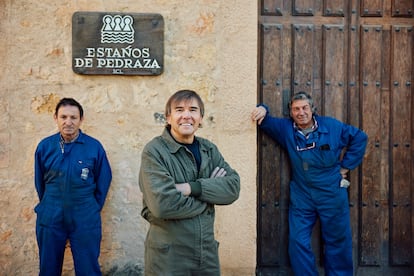
The mansion that houses Estaños de Pedraza would be a dream come true for any creator or entrepreneur looking to set up a workshop of their own. It’s perfect for those who want to escape the city. For Gorete, Andrés and José Luis, it has been their home. They do not know what they’ll do with the house once they leave. “Come and set up a nightclub; let’s see if that way we can bring the young people back and liven up the town with something other than tourism,” they joke. They still have their hunting (“roe deer, foxes, partridges, rabbits, hares,” they say, listing the possibilities), gathering mushrooms, walking their dogs... in other words, free time. They haven’t fully decided what to do with it, but they’re certain about one thing: “We have been here for almost 50 years doing what we love. And we are enjoying it until the last day. Not everyone can say that about their jobs.”
Sign up for our weekly newsletter to get more English-language news coverage from EL PAÍS USA Edition
Tu suscripción se está usando en otro dispositivo
¿Quieres añadir otro usuario a tu suscripción?
Si continúas leyendo en este dispositivo, no se podrá leer en el otro.
FlechaTu suscripción se está usando en otro dispositivo y solo puedes acceder a EL PAÍS desde un dispositivo a la vez.
Si quieres compartir tu cuenta, cambia tu suscripción a la modalidad Premium, así podrás añadir otro usuario. Cada uno accederá con su propia cuenta de email, lo que os permitirá personalizar vuestra experiencia en EL PAÍS.
¿Tienes una suscripción de empresa? Accede aquí para contratar más cuentas.
En el caso de no saber quién está usando tu cuenta, te recomendamos cambiar tu contraseña aquí.
Si decides continuar compartiendo tu cuenta, este mensaje se mostrará en tu dispositivo y en el de la otra persona que está usando tu cuenta de forma indefinida, afectando a tu experiencia de lectura. Puedes consultar aquí los términos y condiciones de la suscripción digital.
More information
Últimas noticias
From digital curfews to blocking apps: How technology experts protect their children online
Why the price of coffee has skyrocketed: from Brazilian plantations to specialty coffee houses
Confined to a Cuban hospital: When electricity is a matter of life or death
Pinochet’s victims grapple with José Antonio Kast’s rise in Chile
Most viewed
- Pablo Escobar’s hippos: A serious environmental problem, 40 years on
- Reinhard Genzel, Nobel laureate in physics: ‘One-minute videos will never give you the truth’
- Why we lost the habit of sleeping in two segments and how that changed our sense of time
- Charles Dubouloz, mountaineering star, retires at 36 with a farewell tour inspired by Walter Bonatti
- The Florida Keys tourist paradise is besieged by immigration agents: ‘We’ve never seen anything like this’
